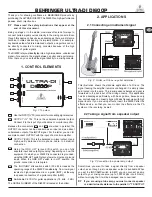
Page 6 of 25
The Constant Fraction Discriminators CFD8c, CFD7x, CFD4c, CFD1c and CFD1x (11.0.1701.1)
3b.
The CFD timing discriminator Modules
The
RoentDek
CFD (Constant Fraction Discriminator) units can be used for improving the timing response of electronic
signals, e.g. as obtained from secondary electron multipliers like MCPs, Photomultipliers, Channeltrons or similar avalanche
counters.
Figure 3.1b: The CFD8 (here: CFD8b version), CFD7x similar
Especially for advanced
RoentDek
detectors with Hexanode (
Hex75
/
Hex100
) the combination of the
RoentDek
FAMP
amplifiers and these CFD units has considerable advantage over the
RoentDek
ATR19
modules in terms of pulse-
pair resolution and timing precision. Using the
RoentDek
CFDs
is recommended for LC-delay-line anode (
DLD40X
or
RS-PMT25
/
40
) and may also improve the performance of the
RoentDek
DLD
or
DET
MCP detectors.
It has to be noted that any operational improvement over the easy-to-use
ATR19
units requires a detailed understanding of
the CFD function and a proper setting of the CFD parameters. The
RoentDek
CFD
units allow a precise adjustment of all
these parameters to different input signal properties (e.g. rise time) and their control by two types of monitor outputs for
achieving optimal timing results. Following the description here is mandatory for successful use.
This manual describes the latest product series
CFD8c
/
4c
/
1c
and
CFD1x
/
7x
.which are part of the
RoentDek
FEE2
/
5
/
7x
/
8
frontend electronics assemblies. Units with earlier version numbers (b or a) are very similar and this manual
may serve as a reference, too. However, the older product versions have fewer features (e.g. no veto option) and can differ in
power requirements, positions of control elements and output options. You may request an older manual version from
RoentDek
for those devices.
All CFD units (except for the “x” channels) can be equipped with boards to operate bipolar signals as from the
RoentDek
bFAMP
modules. If you have received CFD modules containing such boards please review first Chapters 3b.1 to 3b.3 and
then refer to Chapter 3b.7 to learn about the difference between the standard CFD and the
RoentDek
bCFD
settings.
3b.1
General description
If a source produces signals with different pulse heights, a simple comparator circuit or leading-edge discriminator unit will
produce a digital output signal with a time jitter on the order of the input signal’s rise time, thus limiting the achievable timing
precision.
The CFD circuit was designed to deliver a “digital” output signal (e.g. NIM) with timing properties almost independent from
the pulse height for all signals above a selectable threshold level. If the CFD is properly adjusted to the input signal’s
properties, the jitter of this digital “timing output” signal can be reduced by at least a factor of 100 compared to leading-edge
discrimination, as long as the pulses are fairly above noise and the normalized input signal width (the FWHM) does not vary as
function of pulse height. The
RoentDek
CFD
units have a bandwidth of about 300 MHz, require
negative input signals
on the
In
socket and provide 3 such timing outputs as NIM signals from sockets labelled NIM-Out on the front panel. Some
units are available with additional ECL outputs on request or TTL output (
CFD1c
only). The input signal pulse height should
not exceed -2 V and there is no good temporal resolution to expect for signals smaller than -100 mV.
If signals or levels >
2 V or smaller -2 V are connected to the CFD input the circuit can be damaged
. For operation with signals beyond the
safe range
RoentDek
can supply passive attenuators or inverter plugs (
pAtt
and
pInv
).
RoentDek
offers three different case versions hosting 8(7), 4 or 1 CFD channels, some with pulse height determination
option (
CFDx
) on one of the channels.
The
CFD8c
(see Figure 3.1b) is a standalone unit with 8 independent channels. In the version
CFD7x
one channel is replaced
by a circuit allowing for a pulse height determination on one channel. These units are the recommended versions for operating
RoentDek
Hexanode
Delay-line detectors. The
CFD8c/7x
are standalone modules for 19” racks (one height unit) and







































